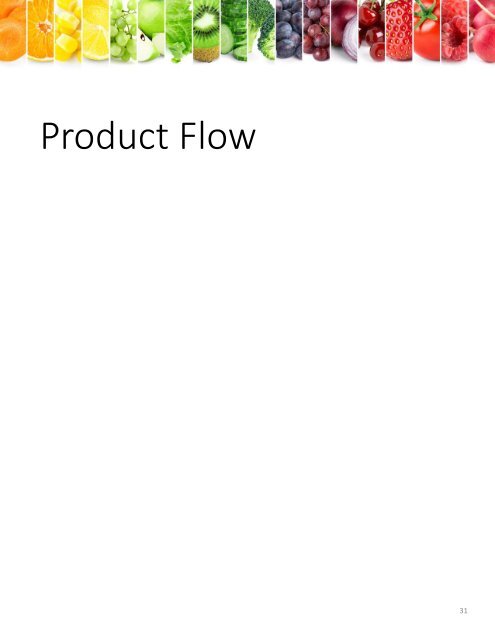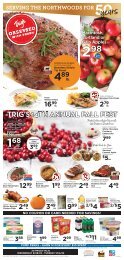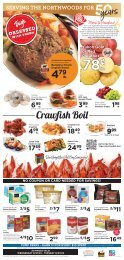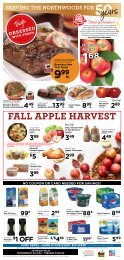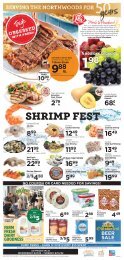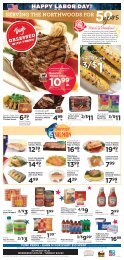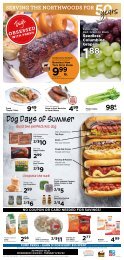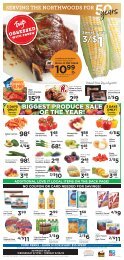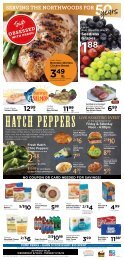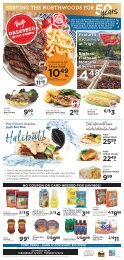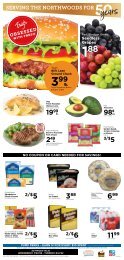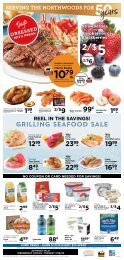Create successful ePaper yourself
Turn your PDF publications into a flip-book with our unique Google optimized e-Paper software.
Product Flow<br />
31
Product Flow – The Food Chain<br />
There is much more to a supermarket than what you see on the sales<br />
floor. An entire series of events must occur before any <strong>product</strong> is<br />
displayed on the sales floor for purchase. You are a key part of this<br />
Food Chain!<br />
Cold Chain Integrity<br />
• Maintaining the proper temperature for our perishable items is essential. This<br />
process preserves the quality and “integrity” of our fresh <strong>product</strong>s from the field<br />
to the sales floor for our Guests.<br />
• Every day there are deliveries to our produce departments. Each delivery must be<br />
received properly to ensure the correct items and amounts as well as the top<br />
quality we demand for our Guests.<br />
• Items must be brought directly, with as little delay as possible, to the backroom or<br />
cooler areas as soon as they are inspected and signed-for to uphold the cold<br />
chain integrity. Keep in mind for every ten degrees above 34 degrees the shelf life<br />
of produce items will be cut in half.
Product Flow – Receiving Product<br />
Procedure for receiving Produce;<br />
• When receiving a produce delivery, it is important to maintain the “Cold Chain”.<br />
• Inspect the temperature of the truck at the time of delivery. In our part of the<br />
country, the weather can be both very hot or very cold. The <strong>product</strong> shelf life<br />
can be affected if the refrigeration of the truck is not at the proper<br />
temperature for the duration of time <strong>product</strong> is transported from the<br />
warehouse to the store.<br />
• If the <strong>product</strong> is refrigerated, it must be received at the correct temperature<br />
(32 to 41° F).<br />
• Product that is stored at room temperature must be separated from the<br />
<strong>product</strong> that is stored in a cooler.<br />
• Be sure to separate any mixed –department pallets immediately. Notify the<br />
other departments of the delivery and ensure their <strong>product</strong>s are properly<br />
stored as well.<br />
• Do not leave pallets on the loading dock or in the backroom more than 20<br />
minutes of receiving. Be certain to put refrigerated <strong>product</strong> into the storage<br />
cooler as soon as possible. Product can break down and become unsafe or<br />
lower in quality when “temperature abused”.<br />
Inspect the temperature of the truck at the<br />
time of receiving the delivery. Check internal<br />
temperature of <strong>product</strong> with a stem<br />
thermometer.<br />
Move pallets in the cooler<br />
immediately upon receiving<br />
and store until pallets are down<br />
stacked<br />
Never leave pallets on the back dock or in<br />
receiving
Product Flow – Receiving Product<br />
Procedure for receiving Produce;<br />
• Verify the invoice for accuracy. Ensure that all of the <strong>product</strong> is present and that<br />
it matches the invoice..<br />
• Verify for acceptable quality. We do not want to accept damaged, spoiled or low<br />
quality <strong>product</strong>. Since the method in refusing <strong>product</strong> can vary widely by suppler<br />
as well as the potential out of stock situation refusing <strong>product</strong> may cause, you<br />
should follow these simple steps;<br />
• Assess how many cases are involved.<br />
• Alert your Department Lead or the Person in Charge of the situation and<br />
follow their guidance.<br />
• Checked for code dating – in code and with an acceptable amount of in-code<br />
days remaining. Note: This varies widely by <strong>product</strong>. See your Department<br />
Manager for guidance and questions.<br />
• Important – Organically grown <strong>product</strong>s (known as “Organics”) may have a<br />
slightly different appearance than non-organic <strong>product</strong>s. Only experienced<br />
Associates should receive Organic <strong>product</strong>s. See your Department Lead for<br />
guidance and direction.<br />
Inspect each pallet to ensure <strong>product</strong><br />
is properly stacked, not turned over or<br />
damaged.<br />
Inspect highly perishable items for quality<br />
immediately upon receiving . Inspect<br />
several cases to get better sample size..
Product Flow – Receiving Bananas<br />
Special Care items;<br />
• Certain <strong>product</strong>s need special care when we receive<br />
and store them. At the top of that list is Bananas.<br />
• The internal case temperature of bananas upon receipt<br />
should be between 51 to 56 degrees F. They must<br />
never be frozen or exposed to excessive heat.<br />
• If you find the <strong>product</strong> has been temperature-abused,<br />
follow the procedures and guidance of your<br />
department manager.<br />
Check the temperature of at<br />
least 3 cases of bananas by<br />
inserting a stem thermometer<br />
in the bottom of a banana<br />
Bananas are stored in a dry area in the back room that is away from drafts, doors or<br />
other possible locations where the temperature can fluctuate quickly.<br />
Bananas also require room to breath. Within an hour of receiving the <strong>product</strong>, they<br />
must be “capped and air stacked”<br />
1. Remove the top of each case, turn the top of the case up-side-down and<br />
insert the bottom portion of the case into the top. This helps provide<br />
strength for proper stacking.<br />
2. Remove any cardboard covering the <strong>product</strong> and unwrap the plastic<br />
covering the <strong>product</strong> . Roll the plastic over the sides of the case<br />
3. Restack the cases in alternating direction to expose the most amount of<br />
<strong>product</strong> to the air in the room.<br />
See the <strong>product</strong> information sheet on bananas for more detail on how to handle<br />
them and why they matter so much to the produce department.<br />
Bananas are very temperamental and require care and<br />
attention to ensure proper ripening. Time is critical, it is<br />
important to properly store bananas as quickly as possible<br />
after delivery.
Product Flow – Storing Product<br />
Whether the <strong>product</strong> we receive is refrigerated, frozen or at room temperature, how<br />
we store it is an important part of the <strong>product</strong> <strong>flow</strong>.<br />
Some <strong>product</strong>s are stored under refrigeration and others stores at room temperature.<br />
Below are the items that are typically not stored in the cooler;<br />
• Potatoes<br />
• Onions<br />
• Tomatoes<br />
• Avocados Nuts (pistachios, peanuts, etc.)<br />
• Bulk foods<br />
• Any other non-refrigerated items<br />
Remember –<br />
Bananas never<br />
go into the<br />
cooler!<br />
Note; “Organic” <strong>product</strong>s must be stored separately from non-organic <strong>product</strong>s<br />
to avoid “cross contamination” and for ease of identification.<br />
Organization is very important;<br />
• It provides the correct amount of storage space for each department, especially when multiple<br />
departments share the same storage space<br />
• Reduces the time it takes to find <strong>product</strong> to bring to the sales floor<br />
• Helps our order-writers know the <strong>product</strong> we have on-hand already<br />
• Avoids needless damage to <strong>product</strong> during storage<br />
• Helps create a safer and more pleasant workplace<br />
Each backroom and storage cooler has a general organizational plan that maps out<br />
where <strong>product</strong> is to be located during storage. See your department manager for your<br />
department’s specific plan .<br />
When a delivery is received, it is common that some of the <strong>product</strong> is needed on the<br />
sales floor right away. Be sure that this need does not create a temperature-abuse<br />
situation. Short-cuts can be costly!
Product Flow – Storing Product<br />
Breaking down and stacking a delivery is an important part of maintaining an<br />
organized cooler and backroom.<br />
FIFO – First In First Out<br />
FIFO is a method of <strong>product</strong> rotation and is an important part of maintaining<br />
freshness and quality. It all starts in the cooler and backroom.<br />
Rotation means that the newest <strong>product</strong> is stored behind or under the<br />
older <strong>product</strong> already on-hand. This practice helps ensure that the older<br />
and more ripe <strong>product</strong> is selected for stocking on the sales floor FIRST.<br />
Note: There are exceptions to the FIFO rule. Sometimes new <strong>product</strong> will arrive<br />
that is riper than the <strong>product</strong> on-hand. When this occurs, it is smart to place the<br />
riper <strong>product</strong> ahead of what is already on-hand. When you suspect this has<br />
occurred, ask your department manager or an experienced associate for guidance.<br />
Make sure the item description is facing<br />
out to properly identify when retrieving<br />
<strong>product</strong> to work to the sales floor.<br />
Keep like items together,<br />
especially <strong>product</strong> received in<br />
ice.
Product Flow – Code Dating<br />
To ensure that we are using the older <strong>product</strong> first, we write the date each case<br />
was received. This practice is called Code Dating.<br />
It is not unusual for the person breaking down and stacking the deliveries, is not<br />
the same person that will stock some of those items on the sales floor. Code dating<br />
is a simple and effective method of communicating between shifts.<br />
To properly code date;<br />
• Use a black marker. Some cases are coated in wax or are damp and a marker may<br />
now work well. In those instances, a marking label or label gun may be used. See<br />
your department manager for the method your department is using.<br />
• Record the date the <strong>product</strong> was received in the upper right-hand corner of each<br />
item.<br />
• Use a simple month/day method (example – 3/10 for March 10 th ). The year is not<br />
needed and should not be used.
Product Flow – Skill Check<br />
General Knowledge<br />
Clear understanding of shrink - able to describe it, identify when and where it occurs<br />
and the impact it has on the department's profitability<br />
Competency<br />
(Date)<br />
Instructor<br />
(Initials)<br />
Clear understanding of "Cold Chain Integrity" - able to describe it and why it matters.<br />
Assist in Receiving / Breaking Down /Storage of a Large Delivery<br />
Receiving the truck<br />
Checking Temps<br />
Check for quality, including bananas<br />
Invoice count verification<br />
Proper storage location (dry storage or cooler)<br />
Full rotation<br />
Code dating<br />
Capping and storing bananas<br />
Competency<br />
(Date)<br />
Instructor<br />
(Initials)


